
The Royal Navy (RN) is the naval warfare force of the United Kingdom, British Overseas Territories and Crown Dependencies, and a component of His Majesty's Naval Service. Although warships were used by English and Scottish kings from the early medieval period, the first major maritime engagements were fought in the Hundred Years' War against France. The modern Royal Navy traces its origins to the early 16th century; the oldest of the UK's armed services, it is consequently known as the Senior Service.

In British maritime law and custom, an ensign is the identifying flag flown to designate a British ship, either military or civilian. Such flags display the United Kingdom Union Flag in the canton, with either a red, white or blue field, dependent on whether the vessel is civilian, naval, or in a special category. These are known as the red, white, and blue ensigns respectively.

The Royal Fleet Auxiliary (RFA) is a naval auxiliary fleet owned by the UK's Ministry of Defence. It is a component of His Majesty's Naval Service and provides logistical and operational support to the Royal Navy and Royal Marines. The RFA ensures the Royal Navy is supplied and supported by providing fuel and stores through replenishment at sea, transporting Royal Marines and British Army personnel, providing medical care and transporting equipment and essentials around the world. In addition the RFA acts independently providing humanitarian aid, counter piracy and counter narcotic patrols together with assisting the Royal Navy in preventing conflict and securing international trade. They are a uniformed civilian branch of the Royal Navy staffed by British merchant sailors. The RFA is one of five RN fighting arms.

Grog is a term used for a variety of alcoholic beverages.
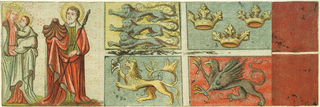
A maritime flag is a flag designated for use on ships, boats, and other watercraft. Naval flags are considered important at sea and the rules and regulations for the flying of flags are strictly enforced. The flag flown is related to the country of registration: so much so that the word "flag" is often used symbolically as a metonym for "country of registration".

The White Ensign, at one time called the St George's Ensign because of the simultaneous existence of a crossless version of the flag, is an ensign worn on British Royal Navy ships and shore establishments. It consists of a red St George's Cross on a white field, identical to the flag of England except with the Union Flag in the upper canton.

The commissioning pennant is a pennant flown from the masthead of a warship. The history of flying a commissioning pennant dates back to the days of chivalry with their trail pendants being flown from the mastheads of ships they commanded. Today, the commissioning pennants are hoisted on the day of commissioning and not struck until they are decommissioned. Some navies have a custom of flying a "paying off" or "decommissioning pennant," the length of which often reflects the length of service of the warship.

Trafalgar Day is the celebration of the victory won by the Royal Navy, commanded by Vice-Admiral Horatio Nelson, over the combined French and Spanish fleets at the Battle of Trafalgar on 21 October 1805.
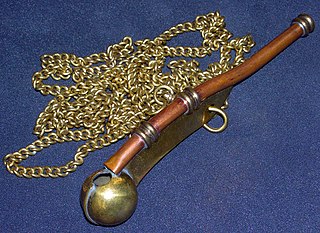
A boatswain's call, pipe, or bosun's whistle is a pipe or a non-diaphragm type whistle used on naval ships by a boatswain.
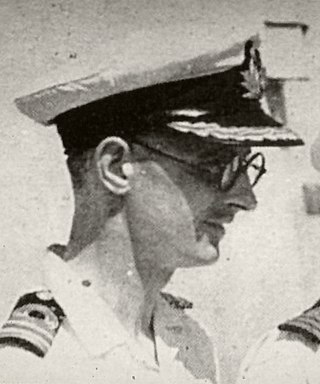
Commander Alwyn Thomas Lavender Covey-Crump was a British officer of the Royal Navy. An assistant to the Chief of Naval Information, he was responsible in the mid-1950s for compiling a record of Jack-speak and other historical marine linguistic details. The first edition appeared on 17 May 1955. The compilation, now continually updated, has led to the term Covey-Crump itself entering into Royal Navy slang.
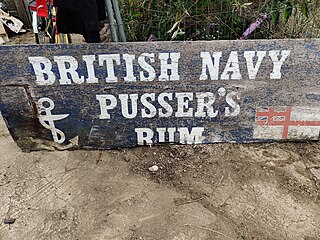
Pusser's Rum is a brand name of rum produced by Pusser's Rum Ltd., based in the British Virgin Islands. Nine years after the Royal Navy discontinued the daily rum ration in 1970, the company was founded to produce the rum from the original Royal Navy recipe, using a blend of five West Indian rums.

The flag of the United States Navy consists of the seal of the U.S. Department of the Navy in the center, above a yellow scroll inscribed "United States Navy" in dark blue letters, against a dark blue background.
Cyril Tawney was an English singer-songwriter and a proponent of the traditional songs of the West of England, as well as traditional and modern maritime songs.

Uckers is a board game for two to four players traditionally played in the Royal Navy. It has spread to many of the other arms of the UK Armed Forces as well, including the Commonwealth Forces. It can now commonly be found in the Royal Marines, Army Air Corps, Royal Canadian Navy, Royal New Zealand Navy, Royal Australian Navy, Royal Australian Air Force (RAAF), Royal Dutch Navy, and the Royal Air Force (RAF).

The ensign of the United States is the flag of the United States when worn as an ensign. International maritime law—see International Treaty on Law of the Sea, articles 91 and 92—provides that vessels have a "national character" and thus should display a flag (ensign) that corresponds to this national character, especially when in international or foreign waters. Vessels that are formally documented under the federal vessel documentation act, vessels owned by government bodies in the United States, and vessels in the U.S. military unquestionably have U.S. national character, and thus properly hoist a U.S. ensign to show their national character. Vessels that are numbered by the states and small, non-registered craft owned by U.S. citizens and not registered in other countries may also hoist a U.S. ensign to show their national character.

A fleet review or naval review is an event where a gathering of ships from a particular navy is paraded and reviewed by an incumbent head of state and/or other official civilian and military dignitaries. A number of national navies continue to hold fleet reviews. Fleet reviews may also include participants and warships from multiple navies.
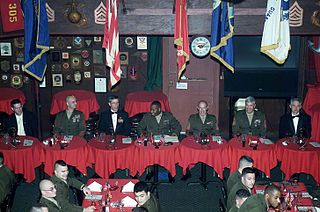
Dining in is a formal military ceremony for members of a company or other unit, which includes a dinner, drinking, and other events to foster camaraderie and esprit de corps.

The Royal Navy Submarine Service is one of the five fighting arms of the Royal Navy. It is sometimes known as the Silent Service, as submarines are generally required to operate undetected.
Surgeon-Captain Richard Tadeusz Jolly OBE was a Royal Navy medical officer who served in the 1982 Falklands War and was later decorated by both the British and Argentine governments for his distinguished conduct during the conflict. He went on to practise and give lectures to medical establishments on his experiences. He was a co-founder, with Denzil Connick, of the South Atlantic Medal Association formed in 1997. He was also the only person to be decorated by both sides for his work in the Falklands War.

A naval tradition is a tradition that is, or has been, observed in one or more navies.



















